In January 2017, upon the inauguration of Donald Trump, a petition to the British Parliament reached over 1,8 million signatures, asking for the prevention of the 45th President of the United States to the United Kingdom. A few weeks later, after debating the petition in Parliament, the Government responded that it “believes the President of the United States should be extended the full courtesy of a State Visit. We look forward to welcoming President Trump once dates and arrangements are finalised.”
As a response, the Carnival of Protest was organised. ‘Dump Trump‘ was a major slogan.
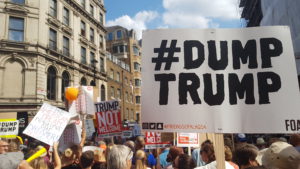
The Trump Baby (a 6 meter tall helium filled inflatable baby with ‘a malevolent face and tiny hands’) was crowdfunded and much controversy about its flights ensued.

On Friday 12 June 2018, 250,000 people took to the streets of London. We were among them, joining the protest in Oxford Circus and marching, singing, moving and clapping all the way to Trafalgar Square. This was a densely visual protest event.
It was fantastic to see such a diversity of signs – both their in their content and form – critiquing Trump in irreverent, angry, loving, satirical, hopeful, reflexive, dismissive, fantastically rude and even typically polite ‘British’ ways. This wide spectrum of tone and sentiment was perhaps indicative of why Trump, despite being a figurehead that stands largely outside the population’s influence, still brought so many thousands of people to the street.
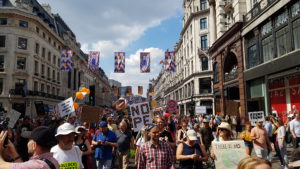
Though unsurprisingly largely ‘left’-leaning, in many ways it felt like all kinds of notes from the political / cultural register came together in the visual protests, in ways rarely seen in response to more domestic issues.
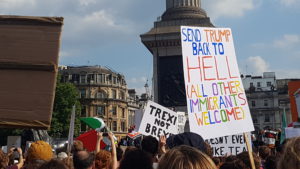
It is difficult to think of another protest where the Queen was somewhat perplexingly invoked as a point of symbolic dissidence (‘The Queen does not approve your policies’) alongside dinosaurs, China, tiny hands, planet earths, hearts, gas masks, babies (both orange and caged), Handmaids (with Trump depicted as Handmaid Ofputin standing out), RuPaul and representations of refugees.
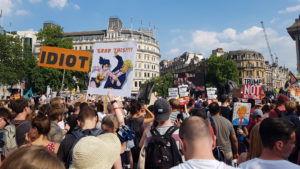

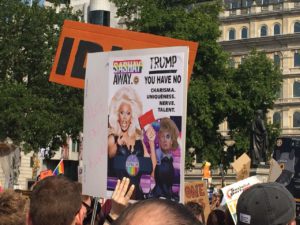
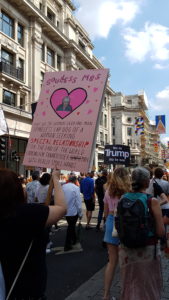

The heterogeneity of the visual protest could perhaps be critiqued as a little incoherent and even superficial – seemingly legitimising criticisms that anti-Trump protesters oversimplify and overlook many of the UK’s own policies that don’t just echo but pre-exist and actively reinforce the racism, fascism, anti-immigration, misogyny and regressive environmental policies being protested as problems optimised in Trump.

In this sense the rally’s speakers helped to confront the hard questions that were somewhat inevitably diluted in the protest’s fantastic visual diversity. The speakers, once again very eclectic in their stances and topics, helped to reinforce the value of resisting Trump as an international figurehead whilst highlighting the just as alarming domestic, historical, institutional and systemic parallels closer to home.
The Carnival of Protest might be over but the fight against Trumpism (hard-selling hard-shelled economic and racial supremacy disguised as patriotic populism) around the world continues.
by Tanya Kant and Eleftheria Lekakis
